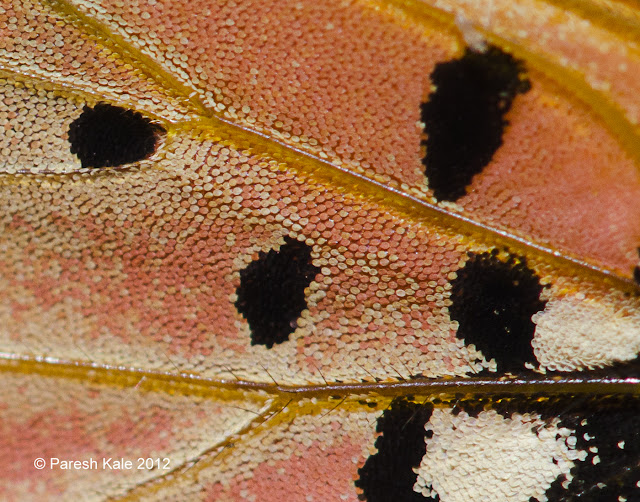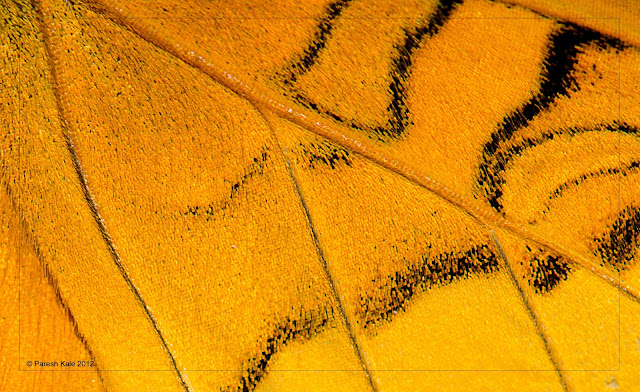Scales of a butterfly
Butterflies are characterized by their scale-covered wings. The coloration of butterfly wings is created by minute scales. These scales are pigmented with melanins that give them blacks and browns, but blues, greens, reds and iridescence are usually created by the micro-structure of the scales. This structural coloration is the result of coherent scattering of light by the photonic crystal nature of the scales The scales are loosely to the wing and come off easily without harming the butterfly.
 |
| Scales of Ringlet |
There a 3 basic types of scale - pigmentary scales, structural scales, and androconia [1].
 |
| Scales of Black Rajah |
Pigmentary scales are mostly flat. Their colour is the result of the presence of melanins and other chemicals. The pigments account for the basic colours found in butterfly wings - black, red and yellow. The juxtaposition of the various coloured scales, and the amount of pigment they each contain, can create the illusion of additional colours such as orange, cream and green.Pigmentary scales are also known as "ground scales" as they effectively form a lower ground layer of colour and pattern on a butterfly's wings. The scales are laid out in neat rows like the tiles on a roof. Each row comprises of alternating pigmentary and structural "cover scales". The latter are larger than the pigmentary scales. They overlap them, and are semi-transparent so the colours of the pigmentary scales can be seen through them.
Structural scales. The fiery hues of Lycaena Coppers, the golden-yellow of Troides Birdwings, the glittering metallic greens of Caria Metalmarks and the dazzling blues of the South American Morphobutterflies are produced by the refraction, diffraction and interference patterns of light as it strikes or passes through the semi-transparent structural scales. Interference patterns are the result of light passing through clear layers of varying density, and being reflected back in such a way that the colours change according to the angle of view. Almost all butterflies and moths have a mixture of pigmentary and structural scales. In combination these can produce any colour ranging from metallic gold to fluorescent orange, iridescent green, sapphire blue, or any other colour seen on butterfly wings. They can even display colours beyond the visible spectrum - most butterflies, in addition to the colours and patterns visible to humans and birds, also have a "hidden" ultra-violet pattern that can only be detected by other butterflies.
Androconia are found mainly on male butterflies. They usually exist as slightly raised dark streaks or patches on the forewings, and often have a mealy appearance. At the base of the androconia are tiny sacs containing scent ( pheromones ). The scent is disseminated via tiny hairs or plumes on the edges of the scales, and used to entice females to copulate.
 |
| scales of Tawny Coster |
- Paints for cars, buildings, or other industrial applications
- Fabrics for textile
- Electronic display screens
Here are some more examples of scales of butterflies:
 |
| Scales of Tailed Jay |
References:
http://www.learnaboutbutterflies.com/Anatomy%203.htm



Very informative. Thank you.
ReplyDeleteThank you Magic eye :-)
DeleteNice and Informative Paresh..
ReplyDeleteThank you so much :-)
DeleteBeautiful and informative.
ReplyDeleteThats encuraging Rajesh Thanks !
DeleteAdvantage of having a micro lens , 1:1 ratio. Thanks Indrani. :-)
ReplyDelete